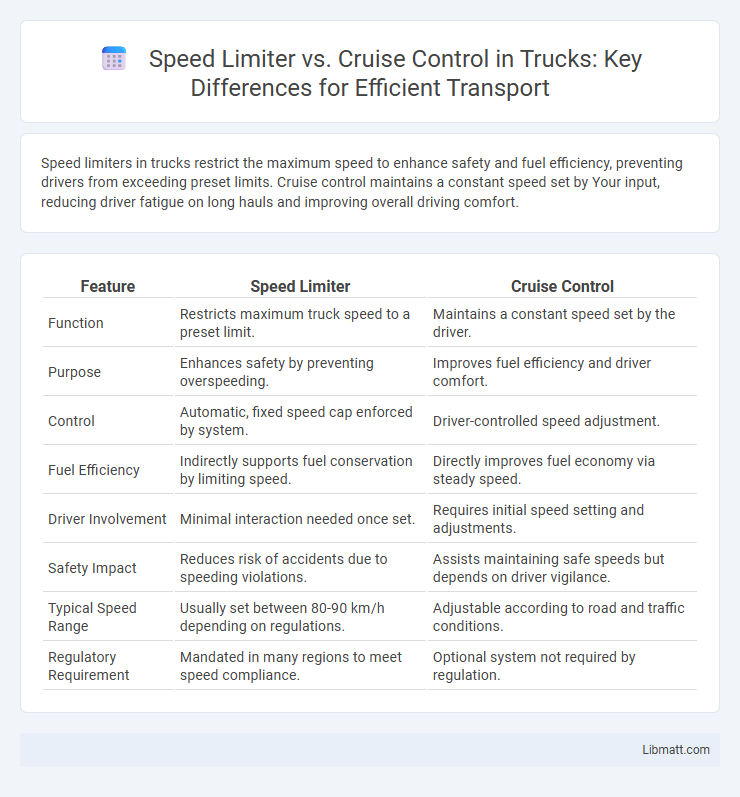Speed limiters in trucks restrict the maximum speed to enhance safety and fuel efficiency, preventing drivers from exceeding preset limits. Cruise control maintains a constant speed set by Your input, reducing driver fatigue on long hauls and improving overall driving comfort.
Table of Comparison
| Feature | Speed Limiter | Cruise Control |
|---|---|---|
| Function | Restricts maximum truck speed to a preset limit. | Maintains a constant speed set by the driver. |
| Purpose | Enhances safety by preventing overspeeding. | Improves fuel efficiency and driver comfort. |
| Control | Automatic, fixed speed cap enforced by system. | Driver-controlled speed adjustment. |
| Fuel Efficiency | Indirectly supports fuel conservation by limiting speed. | Directly improves fuel economy via steady speed. |
| Driver Involvement | Minimal interaction needed once set. | Requires initial speed setting and adjustments. |
| Safety Impact | Reduces risk of accidents due to speeding violations. | Assists maintaining safe speeds but depends on driver vigilance. |
| Typical Speed Range | Usually set between 80-90 km/h depending on regulations. | Adjustable according to road and traffic conditions. |
| Regulatory Requirement | Mandated in many regions to meet speed compliance. | Optional system not required by regulation. |
Introduction to Speed Limiter and Cruise Control
Speed limiters in trucks are electronic devices designed to restrict the maximum speed a vehicle can reach, enhancing safety and regulatory compliance by preventing overspeeding. Cruise control systems maintain a consistent set speed without driver input, improving fuel efficiency and reducing driver fatigue over long distances. Both technologies play crucial roles in truck fleet management by optimizing speed control but serve different operational purposes.
How Speed Limiters Work in Trucks
Speed limiters in trucks function by electronically controlling the engine's maximum speed to prevent exceeding preset limits, enhancing safety and fuel efficiency. These devices are integrated into the vehicle's engine control module (ECM), restricting throttle input to maintain a consistent speed under the cap. Unlike cruise control, which maintains a selected speed for driver convenience, speed limiters enforce legal or company-imposed speed restrictions regardless of driver input.
Understanding Cruise Control Systems
Cruise control systems in trucks maintain a consistent speed by automatically adjusting the throttle, helping reduce driver fatigue on long hauls and improving fuel efficiency. Unlike speed limiters that cap the maximum speed, cruise control allows you to set and sustain your desired velocity for better control during steady driving conditions. Advanced adaptive cruise control systems can also monitor traffic, adjusting speed to maintain safe following distances and enhancing overall road safety.
Key Differences Between Speed Limiter and Cruise Control
Speed limiter in trucks restricts the maximum speed to enhance safety and comply with regulations, preventing drivers from exceeding a set velocity. Cruise control maintains a constant speed chosen by the driver, improving fuel efficiency and reducing driver fatigue during long hauls. Understanding these key differences helps you optimize operational control while ensuring compliance and comfort.
Safety Implications for Truck Drivers
Speed limiters in trucks enhance safety by preventing excessive speeding, reducing the risk of accidents caused by driver error or loss of control. Cruise control maintains a steady speed, helping to reduce driver fatigue on long hauls but may not adapt well to changing traffic conditions, potentially increasing hazard risks. Combining both systems can optimize safety by limiting top speed while allowing controlled, consistent driving.
Impact on Fuel Efficiency and Emissions
Speed limiters in trucks maintain a maximum speed, leading to more consistent engine performance and reduced fuel consumption, which lowers harmful emissions. Cruise control optimizes speed on highways by maintaining a steady pace, preventing unnecessary acceleration and deceleration that waste fuel and increase emissions. Using either technology can enhance Your fleet's fuel efficiency and contribute to environmentally friendly operations by minimizing emissions.
Legal and Regulatory Requirements
Speed limiters and cruise control in trucks serve different regulatory purposes: speed limiters are often mandated by law to cap the maximum speed for safety and emissions compliance, while cruise control remains optional but aids in maintaining consistent speeds to improve fuel efficiency. Many jurisdictions require trucks above a certain weight to have speed limiters set at specified maximums, helping reduce accidents and enforce speed regulations. Understanding these legal requirements ensures your vehicle complies with safety standards and avoids penalties.
Driver Experience and Comfort
Speed limiters enhance driver safety by preventing trucks from exceeding preset speeds, reducing fatigue caused by constant speed adjustments. Cruise control improves comfort by maintaining a consistent speed, allowing drivers to focus more on steering and road conditions rather than speed management. Your driving experience benefits from cruise control's smoother ride but may feel more restrictive with speed limiters that limit acceleration flexibility.
Maintenance and Technology Considerations
Speed limiters in trucks rely on precise electronic calibration and periodic software updates to maintain optimal performance and compliance with regulatory standards, reducing the risk of mechanical wear caused by overspeeding. Cruise control systems incorporate sensors and actuators that require regular inspection and maintenance to ensure smooth operation, as malfunctions can lead to inefficient fuel consumption or safety hazards. Understanding the technological differences helps you implement the appropriate maintenance schedules and diagnostic tools tailored to each system's unique requirements.
Choosing the Right System for Your Fleet
Choosing the right system for your fleet depends on balancing safety, fuel efficiency, and driver convenience. Speed limiters enforce a maximum speed, reducing risks of accidents and excessive fuel consumption, while cruise control maintains a constant speed, improving driver comfort on long hauls. Your decision should consider route conditions, driver behavior, and company safety policies to optimize fleet performance and operational costs.
speed limiter vs cruise control (trucks) Infographic

 libmatt.com
libmatt.com